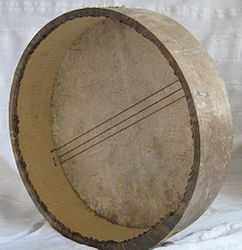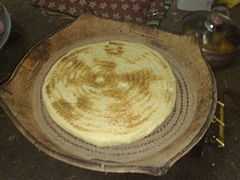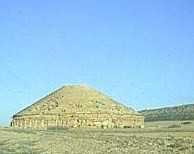Chaoui people
| Total population | |
|---|---|
| 4,500,000 - 7,000,000 | |
| Regions with significant populations | |
|
4,500,000 - 7,000,000  | |
| Languages | |
| Shawiya | |
| Religion | |
| Sunni Islam[1] | |
| Related ethnic groups | |
| Berbers, Maghrebis |
.jpg)
The Shawia people, or Chaouis (Algerian Arabic: شاويه, Shawiya: Išawiyen) are a Berber people who live mainly in the Aurès, Nememcha and Belezma regions located in and surrounded by the Aurès Mountains, a large part of eastern Algeria known in ancient times as Numidia. They call themselves Išawiyen Icawiyen (pronounced [iʃawijən]) and speak the Shawiya language.
History
Historically, the Aurès Mountains served as a refuge for Berber peoples, forming a base of resistance against the Roman Empire, the Vandals, the Byzantine Empire and Arabs. Aurès was also a district of Algeria that existed during and after the Algerian War from 1954 to 1962. It was in this region that Berber freedom fighters started the war.
The patriarch of Berbers is believed to be Madghacen, common ancestor of the Zenata and of the Botri as well. Ibn Khaldun identified the Zenata as Berbers. Modern historians rank this Berber region within the group of Numidians and Gaetuli or the much more ancient such as Meshwesh, Maesulians and Mazaxes, from whom formed the Zenata, the main inhabitants of the Aurès in the Middle Ages. Chaoui clans known by Ibn Khaldoun were the Ifren, Maghrawa, Djerawa, Abdalwadides, Howara and Awarba.
Etymologically, the term Chaoui/Shawi derives from the word Ic "horn", allegedly a reference to the national god of the Numidians, Amun, who is depicted as a human head with the horns of a ram.
After the independence of Algeria, the Chaouis remained localized mainly in the Auresian region. They represent the first ethnic group in Algeria and second Berber-speaking group in terms of number of speakers, the first being the Kabyle.
Physical anthropology

Shawiya Berbers are defined as Nordic since 1939.[2]
The mountain agriculturalists are best represented by two groups of tribes: the Shawia [sic] and the Kabyles, Both of these Berber groups are noted for their European-like features and fair skins; blondism of a high order is frequently attributed to them in the non-statistical literature. (...)
The notable fact about the Shawia is that, in a metrical sense, they are identical with northwestern European Nordics. One could substitute the means of the Shawia sample of Randall-MacIver and Wilkin for those of a characteristic eastern Norwegian province without serious discrepancy. (...)
Although the Shawia are so Nordic Anthropologically, and although they are characteristically white-skinned, they are for the most part brunet in hair and eye color. Only some 30 per cent have mixed or light eyes and 96 per cent are listed as having black head hair.—The Races of Europe, pp. 476–477[2]
The Nordic presence in northern Africa is ancient as the Egyptian monuments of the Middle Kingdom, and perhaps older. They survive today mostly in Aures mountains of Algeria, the mountains of the Rif, the Djurdjura and others are found in the Canary Islands.[3]
Language
The Shawiya language (Berber: ta-Chawi-t) is the Zenati variety of the Berber language. Shawiya Berber is a closely related cluster of dialects spoken in the Aurès region (Berber: Awras) of eastern Algeria and surrounding areas including Batna, Khenchela, south Sétif, Oum El Bouaghi, Souk Ahras, Tébessa, and the north part of Biskra. Recently the Shawiya ta-Mazigh-t language, together with the Kabyle language, has begun to achieve some cultural prominence due to the Berber cultural and political movements in Algeria.
Culture and art
 Bendir with snares |
 Chaoui jewelry, Museum of Man, Paris, during an exhibition Germaine Tillion. |
 Chaoui bread. |
Chaoui music is a specific style of Northern Africa. The Shawia dance is called Rahaba; men and women dancing at weddings. There are many 20th century singers, such as Aïssa Djermouni, Ali Khencheli, Massinissa, Ishem Boumaraf, Djamel Sabri, Houria Aïchi, etc.
Chaoui painters and sculptors (of whom there are many) include Cherif Merzouki, Abdelkhader Houamel, Hassane Amraoui, Adel Abdessemed, and Mohamed Demagh.
The Fantasia (culture) is a traditional exhibition of horsemanship in the Aurès performed during cultural festivals.
References
- ↑ 1.0 1.1 "Shawiya of Algeria". joshuaproject.net. Retrieved September 11, 2012.
- ↑ 2.0 2.1 Coon, Carleton Stevens (1939). "The Mediterranean World". The Races of Europe. New York: The Macmillan Company. pp. 476–477. OCLC 575541610. Retrieved 16 June 2013.
The mountain agriculturalists are best represented by two groups of tribes: the Shawia and the Kabyles, Both of these Berber groups are noted for their European-like features and fair skins; blondism of a high order is frequently attributed to them in the non-statistical literature.
The notable fact about the Shawia is that, in a metrical sense, they are identical with northwestern European Nordics. One could substitute the means of the Shawia sample of Randall-MacIver and Wilkin for those of a characteristic eastern Norwegian province without serious discrepancy. - ↑ Coon, Carleton Stevens (1939). "The Mediterranean World". The Races of Europe. New York: The Macmillan Company. p. Plate 30. OCLC 575541610. Retrieved 16 June 2013.
Nordics are ancient in Northern Africa as the Egyptian monuments of the Middle Kingdom, and perhaps older. They survive today mostly in Aures mountains of Algeria, the mountains of the Rif in morocco, the Djurdjura in tunisia and others are found in the Canary Islands.
Bibliography
|
|
Film
- Hakkar A., La maison jaune, 2008.
External links
 Media related to Chaoui people at Wikimedia Commons
Media related to Chaoui people at Wikimedia Commons- Chawi people in 1952 on YouTube
- Pictures of Chaouis
- Videos in Chaoui
- chawinet.com (in French)
- http://www.truveo.com/khouya-ya-chaoui/id/2928217872
- Among the hill-folk of Algeria: journeys among the Shawía of the Aurès Mountains (1921) by Melville William Hilton-Simpson
| ||||||
